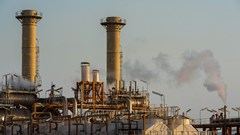Chinese Plastic Makers’ Bets on Cheap US Gas Foiled by Disruptions at Panama and Suez
(Bloomberg) -- The Chinese petrochemical sector’s bet on profiting from a steady supply of cheap US gas to make plastics is quickly going awry, as twin choke-points for shipping upend trade flows and drive up costs.
China has invested heavily in its petchems industry in recent times. But the massive expansion in capacity accelerated last year just as the Chinese economy was stuttering, slowing consumption and creating a glut of plastics across Asia. A large proportion of the new plants use propane, which is mostly imported from the US.
That’s posing a fresh challenge as shipping crises in the Panama Canal and the Red Sea raise freight costs and curb access to US supplies. As a result, the new wave of budding players that employ propane dehydrogenation, or PDH, technology — once seen as a promising corner of the petchems sector — are being forced to scale back.
“These two shipping incidents will hit China’s PDH sector quite badly,” said Larry Tan, the lead Asia-Pacific chemicals analyst at S&P Global.

Traditionally, petrochemicals are produced by cracking naphtha, a refined oil product. PDH is an alternative that’s been gaining popularity, particularly in China, on the promise of cheap gas supplies from the US, where the boom in shale production would provide ample exports. PDH plants use propane, a type of liquefied petroleum gas or LPG, to make propylene, the raw material for many plastics, industrial chemicals and additives.
“Many new projects that were scheduled to come online in the second half of 2023 were delayed,” said Parsley Ong, head of Asia energy and chemicals research at JPMorgan Chase & Co. PDH plants were running at near record-low run rates of around 60% in December, she said.
Some 44% of the new propylene-producing capacity set to open in China from 2020 to 2025 will be based on PDH, according to JPMorgan. In December, margins at those plants fell to an average of $55 a ton in North Asia, compared to nearly $200 the year before, according to S&P Global Commodity Insights.
From 2016 to 2020, PDH plants were generating a positive return on investment, said S&P Global’s Tan. “If you were cracking naphtha instead of liquefied petroleum gas, you were placing yourself at a disadvantage,” he said. However, that cost advantage has since shrunk as naphtha prices have fallen.
Shipping Snarls
The sector is now bracing for another hit from the disruptions at the Panama and Suez canals. The channels serve as shortcuts for tankers plying the trade between the US and Asia, the world’s largest gas exporter and importing region. But low water levels on the former and escalating Mideast tensions affecting the latter have snarled the shipping lanes.
Taking the Panama Canal is usually the shortest route and 80% of the gas cargoes sailed through the channel in 2022, Kpler data show. Now, tankers have to avoid Suez as well, with 77% of shipments to Asia this month forced to round the Cape of Good Hope instead, according to the data.
The end result is longer journey times and higher freight rates that China’s PDH sector can ill-afford.
“Margins will likely stay in break-even or loss-making territory for most of 2024,” said JPMorgan’s Ong, adding that smaller or older units may need to shut down.
The Week’s Diary
(All times Beijing unless noted.)
Thursday, Jan. 18:
- China’s 2nd batch of December trade data, including agricultural imports; LNG & pipeline gas imports; oil products trade breakdown; alumina, copper and rare-earth product exports; bauxite, steel & aluminum product imports
Friday, Jan. 19:
- China December output data for base metals and oil products
- China weekly iron ore port stockpiles
- Shanghai exchange weekly commodities inventory, ~15:30
Saturday, Jan. 20
- China’s 3rd batch of December trade data, including country breakdowns for energy and commodities
On the Wire
Private refiners in China have been buying up Russia’s ESPO oil faster than usual as a standoff with Iranian sellers over pricing continues.
Prices of industrial metals from iron ore to copper are unlikely to be supported by new policies from China this year, withBeijing holding off major stimulus even as the property crisis rolls on.
China’s solar manufacturers are facing a fraught 2024 with concerns about overcapacity, weak profits and production shifting overseas, raising questions about one of the economy’s supposed bright spots.
(Updates with story tout after fifth paragraph)
©2024 Bloomberg L.P.
KEEPING THE ENERGY INDUSTRY CONNECTED
Subscribe to our newsletter and get the best of Energy Connects directly to your inbox each week.
By subscribing, you agree to the processing of your personal data by dmg events as described in the Privacy Policy.
More gas & LNG news

Booming Power Demand Means Longer Wait for GE Vernova Customers

US Widens Sanctions on Iran to Target Lucrative Gas Exports

China Stops Imports of US LNG Amid Trade War, Custom Data Shows

China’s Shipowners Seek to Continue Talks With US on Levies

EU’s Costa Says Russian LNG Phase-Out Makes Room for US Supplies

Fracker Liberty’s Profit Falls to 3-Year Low as Oil Slumps

Uniper and Woodside sign LNG supply agreements

Vista Buys Petronas’ Argentina Oil Stake in $1.5 Billion Deal

Emerson launches Global LNG Solutions Centre in Qatar
















